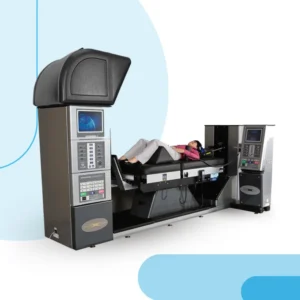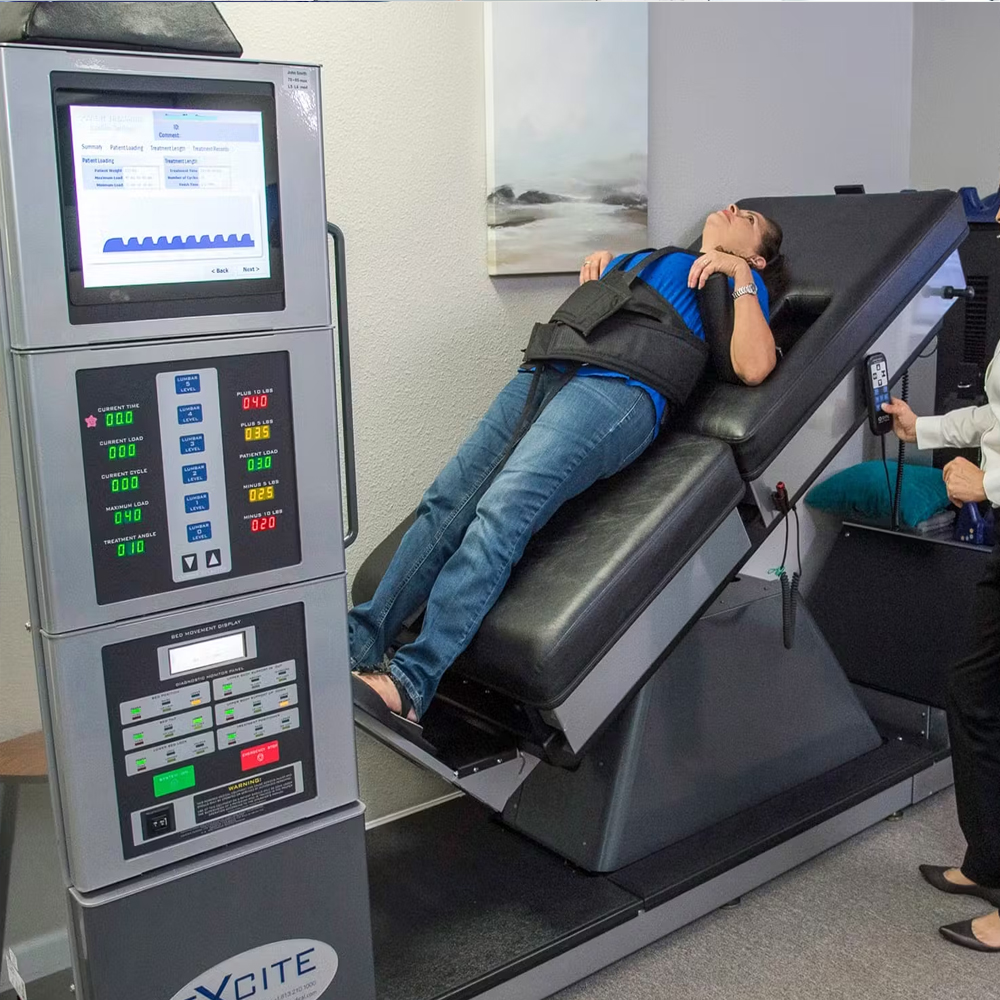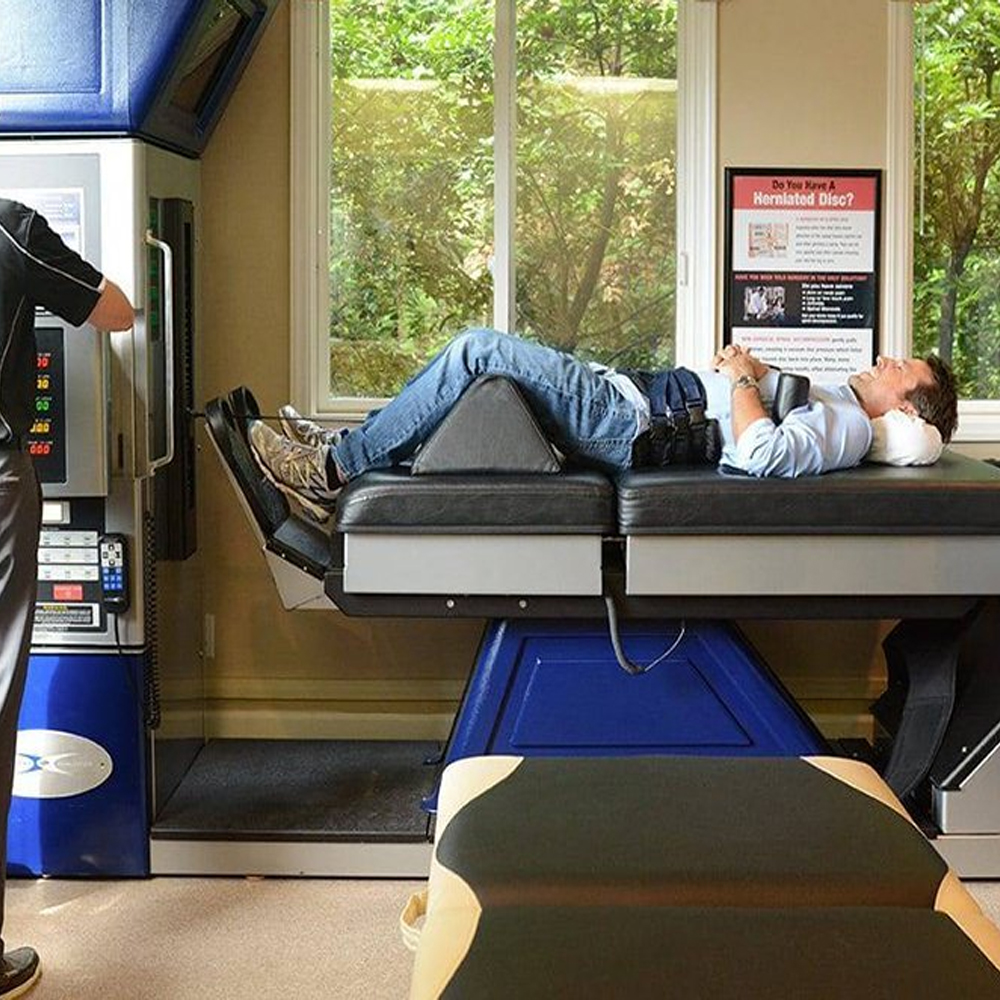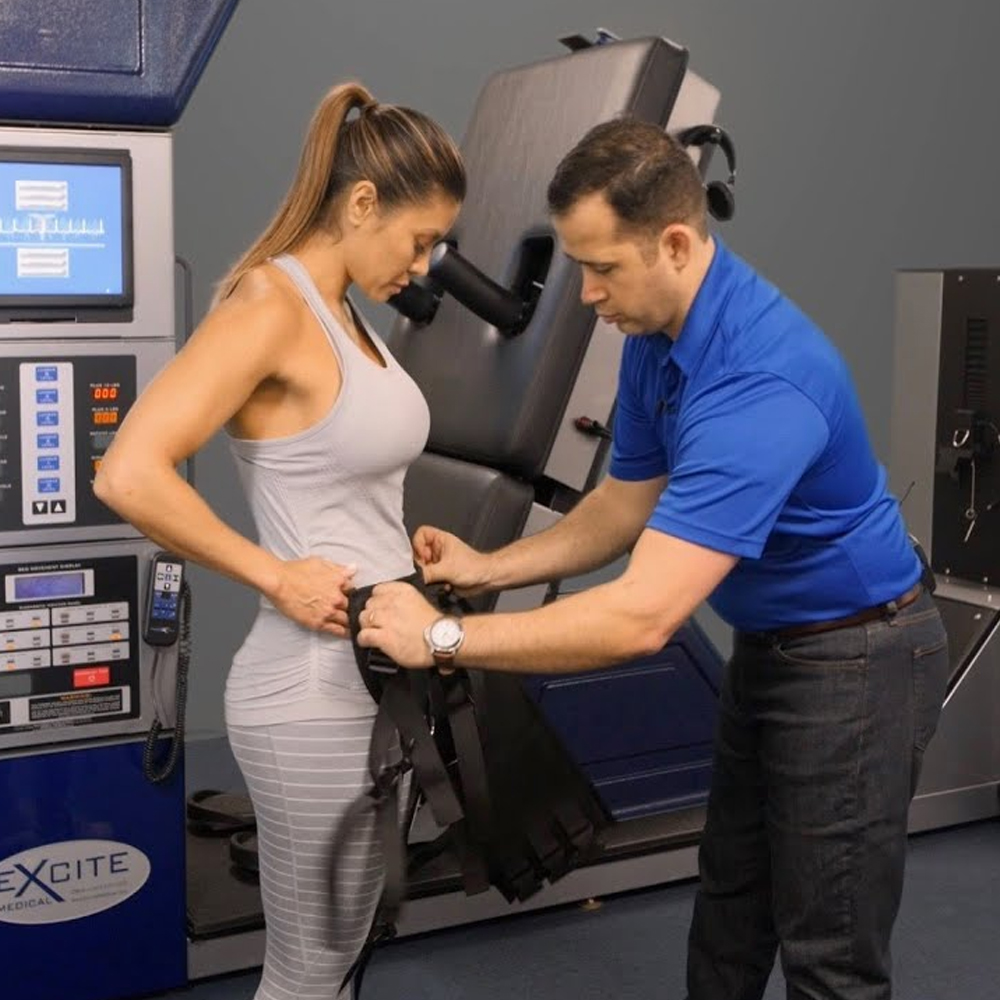Burtom ‣ Technologies ‣ Spinal Decompression System
Language: 🇬🇧 English | 🇹🇷 Türkçe
Spinal Decompression System Overview

 The Spinal Decompression System is a revolutionary medical technology designed to address a variety of spinal conditions and alleviate associated symptoms. This innovative system utilizes non-invasive techniques to gently stretch the spine, relieving pressure on compressed discs and nerves. By creating negative pressure within the spinal discs, the system aims to promote healing, reduce pain, and improve overall spinal health.
The Spinal Decompression System is a revolutionary medical technology designed to address a variety of spinal conditions and alleviate associated symptoms. This innovative system utilizes non-invasive techniques to gently stretch the spine, relieving pressure on compressed discs and nerves. By creating negative pressure within the spinal discs, the system aims to promote healing, reduce pain, and improve overall spinal health.
How It Works: The Spinal Decompression System works by utilizing advanced traction techniques to decompress the spine and alleviate pressure on affected areas. Through a carefully controlled process, the system gently stretches the spine, creating space between the vertebrae and allowing herniated or bulging discs to retract. This reduction in pressure helps to alleviate pain, improve mobility, and promote the body’s natural healing processes.
Clinical Applications: The Spinal Decompression System is commonly used in the treatment of various spinal conditions, including herniated discs, degenerative disc disease, sciatica, and spinal stenosis. It is particularly effective for individuals experiencing chronic back pain, neck pain, or radiating pain in the arms or legs due to spinal compression disorders. Additionally, the system can be customized to target specific areas of the spine, providing tailored treatment based on individual patient needs.
Benefits and Advantages: One of the primary benefits of the Spinal Decompression System is its non-invasive nature, making it an attractive option for individuals seeking alternatives to surgery or medication. The system offers targeted relief by precisely targeting affected areas of the spine, reducing the risk of complications and minimizing downtime for patients. Additionally, many patients experience significant improvements in pain levels, mobility, and overall quality of life following treatment with the Spinal Decompression System.
Future Directions: As technology continues to advance, the Spinal Decompression System is expected to evolve to become even more effective and versatile in addressing a wide range of spinal conditions. Ongoing research and development efforts aim to further enhance the system’s capabilities, improve patient outcomes, and expand its applications in both clinical and home settings. With continued innovation, the Spinal Decompression System holds great promise for the future of spinal care and treatment.
What is Spinal Decompression System and How Does It Work?

The Spinal Decompression System is a non-invasive medical device designed to alleviate symptoms associated with various spinal conditions such as disc herniation, degenerative disc disease, and spinal stenosis. It operates by creating a controlled distraction force on the spine, which helps to decompress spinal discs, relieve pressure on nerves, and promote the movement of water, oxygen, and other nutrients into the affected area. This process aims to reduce pain, improve mobility, and facilitate the body’s natural healing mechanisms.
Basic Principles and Objectives of Spinal Decompression
Spinal decompression is a therapeutic technique aimed at relieving pressure on the spine and nerves. The main principle behind spinal decompression is to create space between the vertebrae, which helps alleviate compression on the spinal discs and nerves. By reducing pressure on the spine, spinal decompression aims to promote healing, relieve pain, and improve overall spinal function.
Effects on the Spine and Nervous System
Spinal decompression has several effects on the spine and nervous system. By creating space between the vertebrae, spinal decompression can help reduce pressure on the spinal discs, which in turn may alleviate symptoms such as pain, tingling, and numbness caused by compressed nerves. Additionally, spinal decompression may improve blood flow and nutrient delivery to the spinal discs, promoting healing and overall spinal health.
Applications and Importance of Spinal Decompression
Spinal decompression is commonly used to treat various spinal conditions, including herniated discs, bulging discs, degenerative disc disease, spinal stenosis, and facet joint syndrome. It is also used to alleviate symptoms associated with sciatica, radiculopathy, and other nerve-related issues. Spinal decompression is an important treatment option for individuals experiencing chronic back pain and other spinal problems, as it offers a non-invasive, conservative approach to pain relief and spinal rehabilitation. Moreover, spinal decompression can help improve mobility, function, and quality of life for individuals suffering from spinal conditions.
Treatment Option for Back and Neck Pain
Spinal decompression serves as an effective treatment option for individuals experiencing back and neck pain. By alleviating pressure on the spinal discs and nerves, spinal decompression helps reduce pain associated with conditions such as herniated discs, bulging discs, degenerative disc disease, spinal stenosis, and facet joint syndrome. It offers a non-invasive approach to pain relief, promoting healing and improving overall spinal function.
Management of Conditions like Disc Herniation and Spinal Stenosis
Spinal decompression is particularly beneficial in managing conditions like disc herniation and spinal stenosis. These conditions often result in compression of the spinal discs and nerves, leading to symptoms such as pain, tingling, numbness, and weakness in the back, neck, arms, or legs. By creating space between the vertebrae, spinal decompression helps alleviate pressure on the affected discs and nerves, thereby reducing symptoms and improving mobility.
Technology and Working Principle of Spinal Decompression System
The spinal decompression system utilizes advanced technology and a sophisticated working principle to achieve therapeutic results. Typically, the patient is positioned on a specially designed table or device that gently stretches and decompresses the spine. This traction-based therapy aims to create negative pressure within the spinal discs, promoting the retraction of herniated or bulging discs and relieving pressure on compressed nerves.
The system’s technology often incorporates computer-controlled algorithms to precisely target the affected spinal segments and customize the treatment parameters according to the patient’s condition and response. Some spinal decompression systems may also feature additional modalities such as thermal therapy, vibration therapy, or electrical stimulation to enhance the therapeutic effects and promote tissue healing.
Overall, the technology and working principle of spinal decompression systems provide a safe, controlled, and effective means of addressing spinal conditions and alleviating associated symptoms, offering patients a non-surgical alternative for managing back and neck pain.
Therapy for Disc Herniation and Spondylolisthesis
Spinal decompression therapy serves as an effective treatment for conditions such as disc herniation and spondylolisthesis. Disc herniation occurs when the soft inner material of a spinal disc protrudes through the tough outer layer, causing compression of nearby nerves and resulting in pain, numbness, or weakness in the back and legs. Spondylolisthesis, on the other hand, involves the forward displacement of a vertebra over the one beneath it, often leading to nerve compression and spinal instability. Spinal decompression therapy helps alleviate the pressure on affected spinal discs and nerves, promoting healing and reducing symptoms associated with these conditions.
Advantages and Benefits of Spinal Decompression
Spinal decompression offers numerous advantages and benefits for individuals suffering from various spinal conditions. One of the primary advantages is its non-invasive nature, as spinal decompression therapy does not involve surgery or medication, making it a safe and effective treatment option for many patients. Additionally, spinal decompression is gentle and comfortable, with most individuals experiencing a relaxing sensation during treatment. Furthermore, spinal decompression therapy is customizable to each patient’s needs, allowing for personalized treatment plans tailored to address specific spinal issues. Overall, the benefits of spinal decompression include pain relief, improved mobility, enhanced spinal health, and an improved quality of life for individuals with spinal conditions.
Alleviation of Pain and Symptoms
Spinal decompression therapy aims to alleviate pain and symptoms associated with various spinal conditions, including disc herniation and spondylolisthesis. By reducing pressure on the spinal discs and nerves, spinal decompression helps alleviate pain, numbness, tingling, and weakness in the back, neck, and extremities. Many patients experience significant relief from their symptoms following a course of spinal decompression therapy, allowing them to resume daily activities with greater comfort and functionality. Additionally, spinal decompression therapy can help prevent the progression of spinal conditions and reduce the need for invasive treatments such as surgery. Overall, the alleviation of pain and symptoms is a key benefit of spinal decompression therapy, improving the overall quality of life for individuals with spinal issues.
Spinal Decompression System: Definition and Operation
The Spinal Decompression System is a non-invasive treatment method designed to relieve pressure on the spine and alleviate symptoms associated with various spinal conditions. By employing a traction-based approach, this system aims to gently stretch the spine, creating negative pressure within the intervertebral discs to promote healing and relieve pain.
Basic Principles and Objectives of Spinal Decompression
The primary principle behind spinal decompression is to reduce pressure on spinal structures, including the intervertebral discs, nerves, and surrounding tissues. By creating a negative pressure environment within the discs, spinal decompression aims to promote the retraction of herniated or bulging discs, alleviate nerve compression, and restore proper spinal alignment. The ultimate objective is to relieve pain, improve mobility, and enhance overall spinal health.
Effects on the Spine and Nervous System
Spinal decompression exerts its effects on the spine and nervous system by gently stretching the vertebral column, which helps to widen the spaces between vertebrae. This stretching action, facilitated by the decompression system, reduces pressure on spinal nerves, alleviates compression on intervertebral discs, and promotes the influx of oxygen, nutrients, and hydration into the affected spinal segments. By enhancing spinal flexibility and circulation, spinal decompression supports the body’s natural healing processes and encourages the regeneration of damaged tissues.
Applications and Importance of Spinal Decompression
Spinal decompression therapy is commonly employed as a conservative treatment option for various spinal conditions, including disc herniation, degenerative disc disease, spinal stenosis, facet joint syndrome, and sciatica. It serves as a valuable alternative to surgical interventions, offering patients a non-invasive approach to alleviate pain, improve functional capacity, and enhance quality of life. Spinal decompression is particularly beneficial for individuals seeking relief from chronic back pain, neck pain, radiating arm or leg pain, numbness, tingling, and muscle weakness associated with spinal disorders. By addressing the underlying causes of spinal dysfunction and promoting tissue healing, spinal decompression therapy plays a crucial role in restoring spinal health and facilitating long-term symptom relief.
Treatment Implementation Considerations
During the implementation of spinal decompression therapy, several key considerations should be taken into account to ensure optimal treatment outcomes and patient safety. These considerations encompass various aspects of treatment planning, patient assessment, and therapy delivery.
Patient Assessment: Prior to initiating spinal decompression therapy, a comprehensive patient assessment should be conducted to evaluate the patient’s medical history, spinal condition, symptom severity, and treatment goals. This assessment may include physical examinations, imaging studies (such as X-rays or MRI scans), and functional assessments to determine the most suitable treatment approach.
Treatment Planning: Based on the findings of the patient assessment, a customized treatment plan should be developed to address the specific needs and goals of the individual patient. This plan may involve determining the frequency and duration of spinal decompression sessions, selecting appropriate traction parameters, and incorporating adjunctive therapies or modalities to complement the decompression therapy.
Equipment Adjustment: Proper adjustment of the spinal decompression system is essential to ensure effective treatment delivery and patient comfort. This includes adjusting the traction force, angle of traction, and treatment duration based on the patient’s condition and response to therapy. Additionally, the patient’s positioning on the decompression table should be optimized to target the affected spinal segments while maintaining comfort and stability.
Monitoring and Feedback: Throughout the treatment session, continuous monitoring of the patient’s response to therapy is essential to make real-time adjustments as needed. Clinicians should closely monitor the patient’s comfort level, response to traction forces, and any signs of discomfort or adverse reactions. Patient feedback regarding treatment intensity, positioning, and overall experience should be actively solicited and incorporated into the treatment process.
Safety Precautions: Safety measures should be implemented to minimize the risk of complications or adverse events during spinal decompression therapy. This includes ensuring proper equipment functioning, adhering to manufacturer guidelines for device operation, and providing adequate patient instruction and supervision during treatment sessions. Clinicians should also be prepared to intervene promptly in the event of any discomfort, adverse reactions, or equipment malfunctions.
Documentation and Communication: Accurate documentation of treatment parameters, patient response, and any relevant observations is essential for monitoring progress and ensuring continuity of care. Clear communication with the patient regarding treatment expectations, potential outcomes, and post-treatment recommendations is crucial to promote patient understanding and compliance with the therapy plan.
By carefully considering these factors during the implementation of spinal decompression therapy, clinicians can optimize treatment efficacy, enhance patient comfort and safety, and maximize overall treatment outcomes.
Treatment Effectiveness and Patient Satisfaction
The effectiveness of spinal decompression therapy is often evaluated based on its ability to alleviate pain, improve functional outcomes, and enhance overall quality of life for patients with spinal conditions. Studies have shown that spinal decompression can lead to significant reductions in pain intensity, increased range of motion, and improved functional mobility in individuals with conditions such as disc herniation, spinal stenosis, and degenerative disc disease.
Patient satisfaction with spinal decompression therapy is also an important measure of treatment success. Patient-reported outcomes, including pain relief, functional improvement, and overall treatment experience, are commonly used to assess satisfaction levels. Research indicates that many patients report high levels of satisfaction with spinal decompression, attributing improvements in pain and function to the therapy.
Improvements in Treatment Protocols and Future Potential
Advancements in technology and research have led to continuous improvements in spinal decompression treatment protocols, enhancing treatment outcomes and expanding the scope of conditions that can be effectively managed with this therapy. These advancements include refinements in traction parameters, customization of treatment protocols based on individual patient characteristics, and integration of adjunctive therapies to enhance treatment efficacy.
The future potential of spinal decompression therapy lies in ongoing research and innovation aimed at further optimizing treatment protocols, expanding the evidence base supporting its efficacy, and exploring new applications for the therapy. Emerging technologies, such as advanced traction systems and real-time monitoring capabilities, hold promise for enhancing the precision and effectiveness of spinal decompression treatment.
Patient Rights and Information About Spinal Decompression System
Patients undergoing spinal decompression therapy have the right to receive clear and comprehensive information about the treatment, including its purpose, potential benefits, risks, and alternatives. This information should be provided in a manner that is easily understandable and allows patients to make informed decisions about their care.
Key aspects of patient rights and information about the spinal decompression system include:
Informed Consent: Patients have the right to provide informed consent before undergoing spinal decompression therapy. This involves a thorough discussion with their healthcare provider about the nature of the treatment, expected outcomes, potential risks, and alternative treatment options.
Privacy and Confidentiality: Patients have the right to privacy and confidentiality regarding their medical information and treatment history. Healthcare providers should adhere to strict confidentiality standards and ensure that patient information is handled in accordance with applicable privacy laws and regulations.
Access to Information: Patients have the right to access information about their spinal decompression therapy, including treatment plans, progress reports, and any relevant medical records. Open communication between patients and healthcare providers is essential to ensure that patients are well-informed and actively engaged in their care.
Respect for Autonomy: Patients have the right to make decisions about their healthcare based on their personal values, preferences, and goals. Healthcare providers should respect patients’ autonomy and involve them in the decision-making process regarding their spinal decompression treatment.
By upholding these principles of patient rights and providing accurate information about the spinal decompression system, healthcare providers can empower patients to actively participate in their treatment journey and make informed choices about their care.
Privacy and Data Protection
Privacy and data protection are paramount considerations in the context of spinal decompression therapy. Healthcare providers must adhere to strict privacy regulations and safeguards to ensure the confidentiality and security of patient information throughout the treatment process. This includes implementing robust data encryption measures, restricting access to patient records to authorized personnel only, and using secure communication channels for transmitting sensitive information. By prioritizing privacy and data protection, healthcare providers can instill trust and confidence in patients, fostering a supportive and secure treatment environment.
Patient Rights and Preferences During Treatment
Respecting patient rights and preferences is fundamental to delivering patient-centered care during spinal decompression therapy. Patients have the right to be informed and involved in decisions regarding their treatment, including the choice of therapy options, treatment goals, and preferences for adjunctive therapies or modalities. Healthcare providers should engage in open and transparent communication with patients, actively listen to their concerns and preferences, and tailor treatment plans to align with their individual needs and preferences. By honoring patient rights and preferences, healthcare providers can enhance treatment satisfaction and promote positive treatment outcomes.
Future Applications and Development of Spinal Decompression
The future of spinal decompression holds exciting possibilities for advancements in technology, treatment protocols, and therapeutic applications. Ongoing research and development efforts are focused on expanding the scope of spinal decompression therapy to address a broader range of spinal conditions and patient populations. This includes exploring innovative treatment modalities, such as advanced traction systems, computer-assisted navigation techniques, and personalized treatment algorithms tailored to individual patient characteristics. Additionally, emerging technologies, such as virtual reality-based rehabilitation programs and wearable devices for home-based therapy, hold promise for enhancing the accessibility and effectiveness of spinal decompression treatment. By embracing innovation and continuously advancing the field of spinal decompression, healthcare providers can improve patient outcomes, expand treatment options, and enhance quality of life for individuals with spinal conditions.
New Technologies and Application Areas
Advancements in technology are driving innovation in the field of spinal decompression, opening up new application areas and treatment possibilities. Emerging technologies, such as robotic-assisted spinal decompression systems, advanced imaging techniques, and computer-assisted navigation systems, are revolutionizing the way spinal conditions are diagnosed and treated. These technologies enable more precise and targeted decompression therapy, improving treatment outcomes and patient satisfaction. Additionally, developments in telemedicine and virtual reality-based rehabilitation programs are expanding access to spinal decompression therapy, allowing patients to receive high-quality care remotely.
Development and Improvement Potential of Treatment Methods
The field of spinal decompression is constantly evolving, with ongoing efforts focused on enhancing treatment methods and protocols to optimize patient outcomes. Research initiatives are exploring novel treatment modalities, such as non-surgical spinal decompression techniques, minimally invasive procedures, and regenerative therapies, to address a broader range of spinal conditions and patient needs. Additionally, interdisciplinary approaches that combine decompression therapy with adjunctive treatments, such as physical therapy, chiropractic care, and pain management interventions, are being explored to improve treatment efficacy and long-term outcomes. Moreover, advancements in biomaterials and tissue engineering hold promise for developing innovative implants and devices that support spinal decompression and promote tissue regeneration. By investing in research and innovation, healthcare providers can unlock the full potential of spinal decompression therapy, delivering more effective, personalized, and holistic care to patients with spinal conditions.
Frequently Asked Questions

Get a Free Second Opinion

I consent to Burtom Health Group using my aforesaid personal data for the purposes described in this notice and understand that I can withdraw my consent at any time by sending a request to info@burtom.com.










